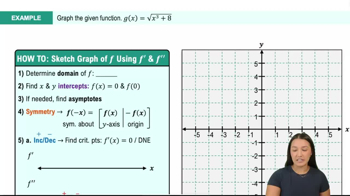Table of contents
- 0. Functions7h 52m
- Introduction to Functions16m
- Piecewise Functions10m
- Properties of Functions9m
- Common Functions1h 8m
- Transformations5m
- Combining Functions27m
- Exponent rules32m
- Exponential Functions28m
- Logarithmic Functions24m
- Properties of Logarithms34m
- Exponential & Logarithmic Equations35m
- Introduction to Trigonometric Functions38m
- Graphs of Trigonometric Functions44m
- Trigonometric Identities47m
- Inverse Trigonometric Functions48m
- 1. Limits and Continuity2h 2m
- 2. Intro to Derivatives1h 33m
- 3. Techniques of Differentiation3h 18m
- 4. Applications of Derivatives2h 38m
- 5. Graphical Applications of Derivatives6h 2m
- 6. Derivatives of Inverse, Exponential, & Logarithmic Functions2h 37m
- 7. Antiderivatives & Indefinite Integrals1h 26m
- 8. Definite Integrals3h 25m
5. Graphical Applications of Derivatives
Curve Sketching
Problem 51a
Textbook Question
{Use of Tech} A different interpretation of marginal cost Suppose a large company makes 25,000 gadgets per year in batches of x items at a time. After analyzing setup costs to produce each batch and taking into account storage costs, planners have determined that the total cost C(x) of producing 25,000 gadgets in batches of x items at a time is given by C(x) = 1,250,000+125,000,000 / x + 1.5x.
a. Determine the marginal cost and average cost functions. Graph and interpret these functions.
 Verified step by step guidance
Verified step by step guidance1
Identify the total cost function C(x) = 1,250,000 + 125,000,000 / x + 1.5x, which represents the cost of producing 25,000 gadgets in batches of x items.
To find the marginal cost function, calculate the derivative of the total cost function C(x) with respect to x, which is C'(x). This will give you the rate of change of the total cost as the batch size changes.
Next, determine the average cost function A(x) by dividing the total cost C(x) by the number of batches produced, which is 25,000 / x. This gives A(x) = C(x) / (25,000 / x).
Graph both the marginal cost function C'(x) and the average cost function A(x) on the same set of axes to visually compare their behaviors as x varies.
Interpret the graphs by analyzing where the marginal cost is less than, equal to, or greater than the average cost, and discuss the implications for production efficiency and cost management.
Was this helpful?

 11:41m
11:41mWatch next
Master Summary of Curve Sketching with a bite sized video explanation from Callie
Start learning




